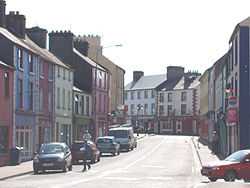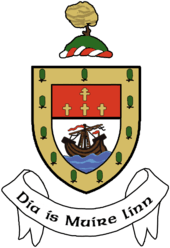Swinford
| Swinford Béal Átha na Muice | |
|---|---|
| Town | |
 | |
 Swinford Location in Ireland | |
| Coordinates: 53°56′30″N 8°57′00″W / 53.9417°N 8.9500°WCoordinates: 53°56′30″N 8°57′00″W / 53.9417°N 8.9500°W | |
| Country | Ireland |
| Province | Connacht |
| County | County Mayo |
| Elevation | 65 m (213 ft) |
| Population (2011)[1] | |
| • Urban | 1,435 |
| Irish Grid Reference | G376004 |
Swinford, historically called Swineford (Irish: Béal Átha na Muice, meaning "ford-mouth of the swine"),[2] is a town in County Mayo, Ireland. It is surrounded by the settlements of Midfield, Meelick, Culmore, Cloonaghboy, Killasser and other villages.[3] It is on the N5 road, located 18 km (11 mi) from Ireland West Airport Knock (formerly known as Knock International Airport). Situated on a tributary of the River Moy, Swinford is known for its fishing waters, including the Callow lakes and the lakes of Conn and Cullin. Swinford was bypassed in 1993 by the N5 route and was the first town in Mayo to be bypassed. The town was the only urban centre in County Mayo to experience a population decline in the 2011 census.
Swinford is used for the filming of TV show Hardy Bucks, as the fictional town of Castletown.
Events
Swinford hosts one of County Mayo's largest summer festivals and has done since the mid-1980s: Siamsa Sraide Swinford, (Fun in the Streets of Swinford). This Street festival of pageantry, céilí dancing, and heritage displays depicts the traditions of East Mayo. This five-day festival takes place in the first week of August and features live bands playing open-air concerts as well as a heritage day, history walks and an international busking competition.[4]
Education
Up to the mid-1980s the town had 3 second level schools: St. Patrick's college, St. Mary's Convent and the Vocational school. All 3 schools amalgamated in August 1992 to Scoil Muire agus Padraig.[5] [6]
Transport
Swinford railway station opened on 1 October 1895, closed for passenger traffic on 17 June 1963 and finally closed altogether on 3 November 1975.[7] At present there is work being carried out to reopen the line.
Swinford Revolt
John Dillon was a long-serving Member of Parliament for East Mayo at Westminster. His major policy issue was the resolution of the Land Question. Dillon took an uncompromising position in favour of the smallholders (small farmers) who sought to gain ownership of the land which they held as tenants from the largely Anglo-Irish landlords. From the middle of the 19th century, ongoing attempts were made at Westminster by the Liberal Party under William Ewart Gladstone to resolve the issue by passing the Irish Land Acts. Irish opinion, while welcoming of the initiative to resolve the injustice, was divided between the moderates, led by William O'Brien, who favoured a conciliatory approach (known as the doctrine of conciliation) and the hardliners. The hardliners supported an aggressive agrarian struggle and sought to advance simultaneously the struggle for Home Rule. On 25 August 1903, Dillon, addressing a meeting of his constituents at the Swinford Workhouse, spoke vehemently against the doctrine of conciliation. This divided the Party and led to the departure of William O’Brien. It became known as the "Swinford Revolt". Despite the turmoil, the Chief Secretary for Ireland, George Wyndham's Irish Land (Purchase Act) 1903 passed at Westminster, resolving the Irish Land Question.[8]
War of Independence
Swinford, like most areas in the West of Ireland saw its share of action during the Irish War of Independence, the struggle to free the country from British occupation. According to the Galway Observer of Saturday, July 24, 1920, in an article entitled "Shots in Swinford":
A military patrol of the Border regiment from Claremorris was fired at on Saturday night at Swinford and two soldiers were severely wounded. The soldiers halted at Swinford courthouse, from which four streets branch and immediately shots were fired at them by unknown parties. The lorry was riddled in several places with several bullets.
The military returned the fire, discharging as many as 500 rounds, with what result did not transpire. The wounded soldiers were conveyed to Claremorris, where their wounds were dressed prior to removal to the Curragh Hospital.[9]
On 27 August 1920 IRA soldiers from Swinford and Bohola attacked and captured Ballyvary RIC Barracks,[10] and on 27 November 1920 two Swinford men, James Henry and Thomas Fraher were convicted at a military court in Galway of possessing weapons and intelligence on the RIC. Both were sentenced to periods of imprisonment.[11]
Local folklore has it that other British patrols were ambushed in rural areas outside the town, and that local Volunteers from the (Old) Irish Republican Army climbed onto the roof of the Royal Irish Constabulary barracks (now the site of the Gateway Hotel) and burnt it to the ground by breaking slates and pouring petrol into the building.
During this period British soldiers were also billeted in the town.
People
- Michael McNicholas, CEO, Bord Gáis Éireann
- Thomas Martin Aloysius Burke, bishop of Albany (New York)
- Ciana Campbell, former RTÉ broadcaster.[12]
- Mary Davis, presidential candidate and disability rights activist is from Kinaffe, between Swinford and Kiltimagh.[13]
- David Heaney, 2006 Mayo Senior Football captain.[14]
- Martin Hennigan, 1984-85 All Ireland Handball 40x20 Singles and 1984 RTÉ Top Ace champion.[15]
- Jack Judge, musician and composer of "It's a long way to Tipperary".[16]
- Joseph Patrick Lydon, double Olympic medalist
- Enda Marren, a member of the Council of State and a former member of the Law Reform Commission, is from Killasser
- Ulick and Des McEvaddy, founders and owners of Omega Air.[17]
- Donncha O'Connell, Dean of Law, National University of Ireland, Galway and former Director of Irish Council for Civil Liberties.[18]
- Patrick O'Connor, former president of the Law Society of Ireland
- Bernard Durkan TD was born in Killasser
- Caitríona Ruane, Stormont Minister for Education and South Down MLA.[19]
See also
References
- ↑ "Census 2006 – Volume 1 – Population Classified by Area" (PDF). Central Statistics Office Census 2006 Reports. Central Statistics Office Ireland. April 2007. pp. 51,109. Retrieved 2011-06-12.
- ↑ Placenames Database of Ireland (see archival records)
- ↑ "Swinford - Set dancing". Western People. 2007-01-10. Retrieved 2007-02-22.
- ↑ "Swinford comes alive for annual Siamsa festival". Western People. 2004-07-21. Retrieved 2007-02-22.
- ↑ "Adjournment Debate - School Accommodation". Dáil Éireann Debates. Office of the Houses of the Oireachtas. 2003-09-17. Retrieved 2007-11-21.
Minister of State at the Department of Community, Rural and Gaeltacht Affairs (Mr. N. Ahern): The school came into operation as a result of an amalgamation of the existing secondary school, Meanscoil Mhuire agus Phádraig, and the local vocational school in August 1992.
- ↑ "Post Primary Schools in County Mayo". Educationireland.ie. Retrieved 2007-11-21.
- ↑ "Swinford station". Railscot - Irish Railways. Retrieved 2007-11-24.
- ↑ Jackson, Ireland 1798-1998: Politics and War, p 152
- ↑ Shots in Swinford. Retrieved 16 July 2014.
- ↑ http://www.dcu.ie/~foxs/irhist/august_1920.htm
- ↑ http://places.galwaylibrary.ie/history/chapter281.html
- ↑ http://www.ceifin.com/conference/34/speaker.html
- ↑ http://thepost.ie/post/pages/story.aspx-qqqt=AGENDA-qqqs=agenda-qqqid=58548-qqqx=1.asp
- ↑ "Head to head: Kieran Donaghy v David Heaney". hoganstand.com. 2006-09-12. Retrieved 2007-02-23.
- ↑ "40x20 senior singles". gaa.ie.
- ↑ TheHarpNews.com
- ↑ "Opportunity Knocks". The Sunday Business Post Online. 2007-01-21. Retrieved 2007-02-23.
- ↑ "Proust Questionnaire: - Donncha O'Connell, NUI, Galway". Galway Advertiser. Advertiser Group. 2002-09-02. Retrieved 2007-11-21.
- ↑ "Swinford native is to be northern Minister for Education". Mayo Advertiser. 2007-04-06. Retrieved 2007-04-09.
